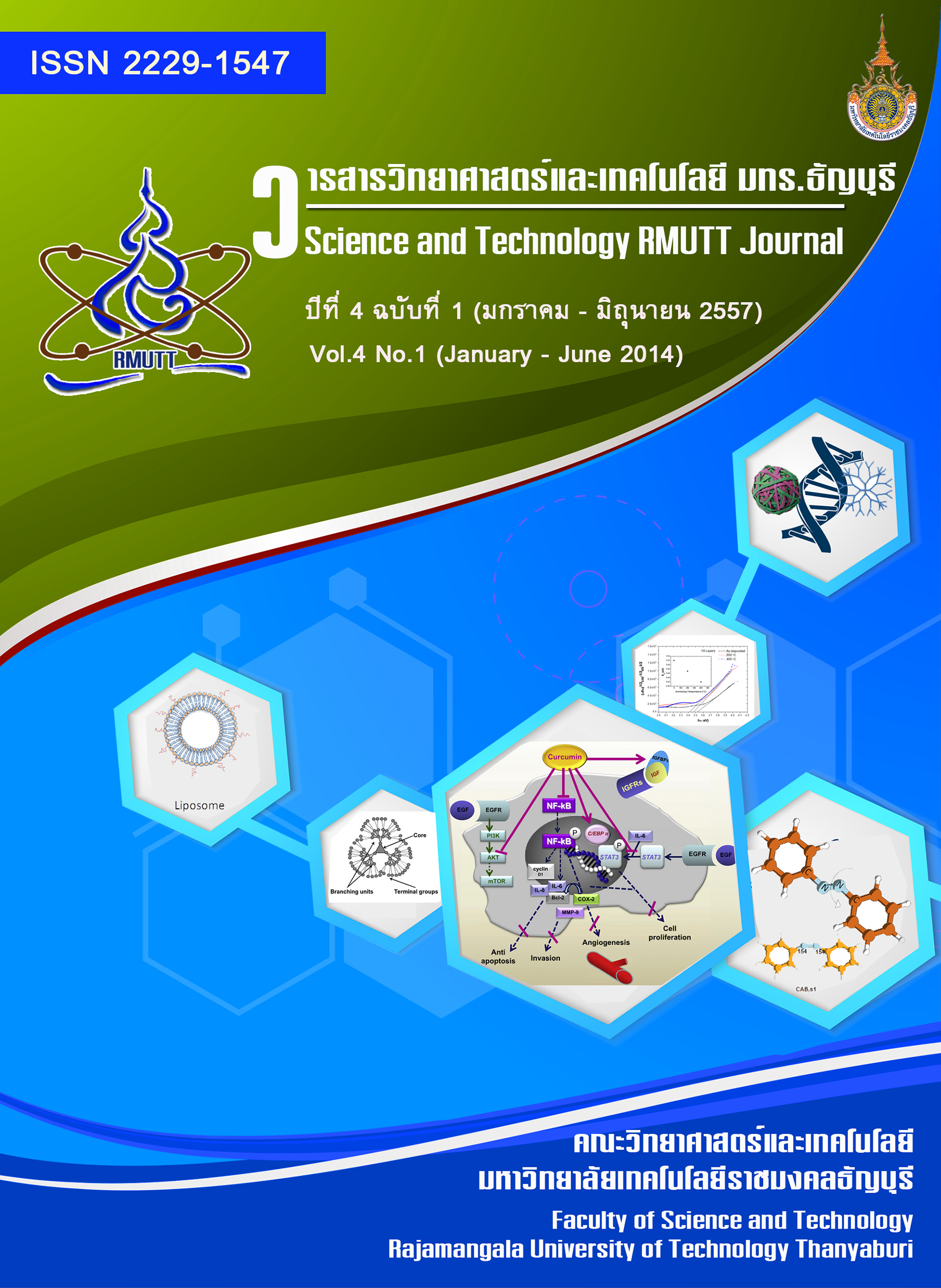The study of photoisomerization of azobenzene in vacuo and chloroform
Main Article Content
Abstract
Azobenzene is among the most important classes of photochromic compound. One of the most interesting properties of azobenzene is the photoisomerization between trans and cis isomers. The two isomers can be switched with different wavelengths of light in different conditions. The study of photoisomerization of azobenzene in vacuo and in chloroform can be a useful information for designing and controlling nanodevices with light. In this work, the photoisomerization of azobenzene has been studied using molecular simulations by twisting the dihedral angle of the N=N double bond, which identifies the trans- or cis-azobenzene, to obtain the potential energy curves of azobenzene in vacuo from rigid torsion cut and the free energy curves of azobenzene in chloroform from umbrella sampling. The results show that cis-azobenzene can photoisomerize more easily than trans-azobenzene both in vacuo and in chloroform because there is a very small energy barrier for isomerization. Moreover, from the dynamics simulations of azobenzene in vacuo on the excited state (S1), it was found that cis-azobenzene transitions from S1 to S0 (ground state), where it begins the isomerization, faster than trans-azobenzene. It also provides higher quantum yield than trans-azobenzene. Therefore, cis-azobenzene can photoisomerize better than trans-azobenzene.
Article Details
References
Asanuma, H., et al., Synthesis of azobenzene-tethered DNA for reversible photo-regulation of DNA functions: hybridization and transcription. Nature Protocols, 2007. 2: p. 203-212.
Toniolo, A., et al., Simulation of the photodynamics of azobenzene on its first excited state: Comparison of full multiple spawning and surface hopping treatments J. Chem. Phys., 2005. 123: p. 234308.
Cembran, A., et al., On the mechanism of the cis-trans isomerization in the lowest electronic states of azobenzene: S0, S1, and T1. J. Am. Chem. Soc., 2004. 126(10): p. 3234-3243.
Ciminelli, C., G. Granucci, and M. Persico, The Photoisomerization Mechanism of Azobenzene: A Semiclassical Simulation of Nanadiabatic Dynamics. Chem. Eur. J, 2004. 10: p. 2327-2341.
Wang, L. and X. Wang, An ab initio study of stable conformation and thermal isomerization of p-aminoazobenzene. J. Mol. Struct: THEOCHEM, 2007. 806: p. 179-186.
Dou, Y., et al., Detailed mechanism of trans–cis photoisomerization of azobenzene studied by semiclassical dynamics simulation. Mol. Phys., 2009. 107(2).
Ootani, Y., et al., Ab initio molecular dynamics simulation of photoisomerization in azobenzene in the nπ* state. J. Chem. Phys., 2009. 131: p. 194306.
Wazzan, N., Cis-Trans Isomerisation of Azobenzenes Studied by NMR Spectroscopy with In situ Laser Irradiation and DFT Calculations. 2009, Edinburgh University: Edinburgh, United Kingdom.
Zimmerman , G., L.-Y. Chow , and U.-J. Paik, The Photochemical Isomerization of Azobenzene. J. Am. Chem. Soc., 1958. 80 (14): p. 3528-3531.
Pietro, B. and S. Monti, Cis-trans photoisomerization of azobenzene. Solvent and triplet donors effects. J. Phys. Chem., 1979. 83(6): p. 648-652.
Nägele, T., et al., Femtosecond photoisomerization of cis-azobenzene. Chem. Phys. Lett., 1997. 272(5-6): p. 489-495.
Cusati, T., G. Granucci, and M. Persico, Photodynamics and time-resolved fluorescence of azobenzene in solution: a mixed quantum-classical simulation. J. Am. Chem. Soc., 2011. 133(13).
Warshel, A. and M. Levitt, Theoretical Studies of Enzymic Reactions: Dielectric, Electrostatic and Steric Stabilization of the Carbonium Ion in the Reaction of Lysozyme. J. Mol. Biol., 1976. 103: p. 227-249.
Granucci, G. and A. Toniolo, Molecular Gradients for Semiempirical CI Wave Functions with Floating Occupation Molecular Orbitals. Chem. Phys. Lett., 2000. 325: p. 79-85.
Stewart, J.J.P., MOPAC 2000. 1999, Fujitsu Limited: Tokyo, Japan.
Jorgensen, W.L., D.S. Maxwell, and J. Tirado-Rives, Development and Testing of the OPLS All-Atom Force Field on Computational Energetics and Properties of Organic Liquids. J. Am. Chem. Soc., 1996. 118: p. 11225-11236.
Ben-Nun, M., J. Quenneville, and T.J. Martinez, Ab Initio Multiple Spawning: Photochemistry from First Principles Quantum Molecular Dynamics. J. Phys. Chem., 2000. 104(22): p. 5161-5175.
Ben-Nun, M. and T.J. Martínez, Ab Initio Quantum Molecular Dynamics. Adv. Chem. Phys., 2002. 121: p. 439-512.
Torrie, G.M. and J.P. Valleau, Nonphysical sampling distributions in Monte Carlo free-energy estimation: Umbrella sampling. J. Comp. Phys., 1977. 23(2): p. 187-199.
Kumar, S., et al., The weighted histogram analysis method for free-energy calculations on biomolecules. I. The method. J. Comp. Chem., 1992. 13: p. 1011-1021.
Tsuji, T., et al., Molecular Structure and Torsional Potential of trans-Azobenzene. A Gas Electron Diffraction Study. J. Phys. Chem. A, 2001. 105(41): p. 9347-9353.
Traetteberg, M., I. Hillmo, and K. Hagen, A gas electron diffraction study of the molecular structure of trans-azobenzene. J. Mol. Struct., 1977. 39(2): p. 231-239.
Serra, F. and E.M. Terentjev, Effects of Solvent Viscosity and Polarity on the Isomerization of Azobenzene. Macromolecules, 2008. 41: p. 981-986.


